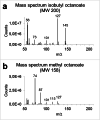Development and validation of a gas chromatography-mass spectrometry method to analyze octanoate enrichments at low concentrations in human plasma
- PMID: 32648105
- PMCID: PMC7413909
- DOI: 10.1007/s00216-020-02801-7
Development and validation of a gas chromatography-mass spectrometry method to analyze octanoate enrichments at low concentrations in human plasma
Abstract
A new method for accurately analyzing octanoate enrichment in plasma was developed and validated. Samples were derivatized directly in plasma by transesterification with isobutanol and were analyzed by gas chromatography-mass spectrometry (GC-MS). This method was developed to analyze the precursor enrichment in a stable isotope tracer protocol. Glyceryl tri[1,2,3,4-13C4] octanoate, a stable isotope-labeled medium-chain triglyceride (MCT), was orally administered in combination with (1) exclusively MCT or (2) a combination of protein, carbohydrates, and MCT to investigate the metabolic route of oral MCT under various conditions. Accurate analysis of octanoate enrichment in plasma at concentrations as low as 0.43 μM (lower limit of quantification, LLOQ) was performed. This is an improvement of about twenty times for the LLOQ for analysis of the enrichment of octanoate when compared with the gold-standard method for fatty acid analysis (methyl esterification). Moreover, we found that' with this gold-standard method, study samples were easily contaminated with (unlabeled) octanoate from other sources, leading to biased, incorrect results. The precision and linearity obtained using the new method were good (coefficient of variation intraday < 9.1%, interday < 9.3%, R2 of the calibration curve > 0.99). The sensitivity was sufficient for analyzing samples obtained using the stable isotope protocol. This new method is more sensitive than methyl esterification and it minimizes the risk of contamination. Graphical abstract.
Keywords: Elongation; Mass spectrometry; Medium-chain triglycerides; Stable isotopes.
Conflict of interest statement
The authors declare that they have no conflict of interest.
Figures






Similar articles
-
Exploring the metabolic fate of medium-chain triglycerides in healthy individuals using a stable isotope tracer.Clin Nutr. 2021 Mar;40(3):1396-1404. doi: 10.1016/j.clnu.2020.08.032. Epub 2020 Sep 4. Clin Nutr. 2021. PMID: 32948349
-
Development and Validation of a New Gas Chromatography-Tandem Mass Spectrometry Method for the Measurement of Enrichment of Glyoxylate Metabolism Analytes in Hyperoxaluria Patients Using a Stable Isotope Procedure.Anal Chem. 2020 Jan 21;92(2):1826-1832. doi: 10.1021/acs.analchem.9b03670. Epub 2020 Jan 3. Anal Chem. 2020. PMID: 31867958 Free PMC article.
-
Glucose and glycerol concentrations and their tracer enrichment measurements using liquid chromatography tandem mass spectrometry.J Mass Spectrom. 2014 Oct;49(10):980-8. doi: 10.1002/jms.3407. J Mass Spectrom. 2014. PMID: 25303387
-
Conversion of octanoic acid into long-chain saturated fatty acids in premature infants fed a formula containing medium-chain triglycerides.Metabolism. 1994 Oct;43(10):1287-92. doi: 10.1016/0026-0495(94)90224-0. Metabolism. 1994. PMID: 7934982 Clinical Trial.
-
GC/MS method for determining carbon isotope enrichment and concentration of underivatized short-chain fatty acids by direct aqueous solution injection of biogas digester samples.Talanta. 2015 Oct 1;143:56-63. doi: 10.1016/j.talanta.2015.04.065. Epub 2015 Apr 29. Talanta. 2015. PMID: 26078128
Cited by
-
Simple, fast and inexpensive quantification of glycolate in the urine of patients with primary hyperoxaluria type 1.Urolithiasis. 2023 Mar 15;51(1):49. doi: 10.1007/s00240-023-01426-6. Urolithiasis. 2023. PMID: 36920530 Free PMC article.
References
-
- Carnielli VP, Sulkers EJ, Moretti C, Wattimena JL, van Goudoever JB, Degenhart HJ, et al. Conversion of octanoic acid into long-chain saturated fatty acids in premature infants fed a formula containing medium-chain triglycerides. Metabolism. 1994;43(10):1287–1292. doi: 10.1016/0026-0495(94)90224-0. - DOI - PubMed
-
- Gillingham MB, Scott B, Elliott D, Harding CO. Metabolic control during exercise with and without medium-chain triglycerides (MCT) in children with long-chain 3-hydroxy acyl-CoA dehydrogenase (LCHAD) or trifunctional protein (TFP) deficiency. Mol Genet Metab. 2006;89(1–2):58–63. doi: 10.1016/j.ymgme.2006.06.004. - DOI - PMC - PubMed
-
- van Harskamp D, van Goudoever JB, Schierbeek H. Stable isotope technology. In: Schierbeek H, editor. Mass spectrometry and stable isotopes in nutritional and pediatric research, 1 edn. Wiley Series on Mass Spectrometry. New Jersey: John Wiley & Sons, Inc; 2017. pp. 45–66.
Publication types
MeSH terms
Substances
LinkOut - more resources
Full Text Sources
Miscellaneous

